Community Education Curricula
| If you wish to request any materials distributed by PBEM, please do so at least two weeks before you need them. You can request materials by completing the online REQUEST FORM. |
This page is intended to serve both the general public and to aid PBEM staff when considering handout updates and ordering materials.
NETwiki distinguishes between printed "Handout Materials" and "Community Education Curricula", and they are posted to different pages:
- Handout Materials are short-form informational resources designed to be used by an individual, typically distributed at community events, and do not necessitate a facilitator or community leader leading neighbors through a learning process.
- Community Education Curricula are long-form informational resources designed for individuals and/or organized neighbors to work through towards a shared resilience goal, and often suggest a neighbor as a "lead facilitator" coordinating the process.
Community Resilience Workbook
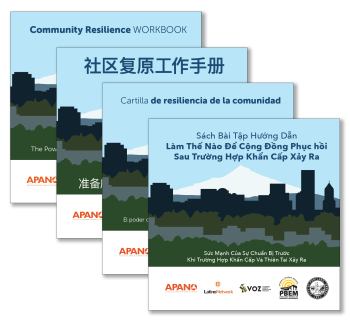
| Item | Last Update | ||||
|---|---|---|---|---|---|
| Community Resilience Workbook | 2019.06.12 | en | es | vi | zh |
| Community Resilience Workbook Facilitators' Guide | 2019.06.12 | en | es | vi | zh |
The Community Resilience Workbook is PBEM's principal community resilience curriculum publication. PBEM produced it in partnership with Voz, APANO, and Latino Network in 2018 and 2019. Before PBEM published the Community Resilience Workbook, staff distributed Map Your Neighborhood (MYN). The Community Resilience Workbook was designed to remedy ongoing problems with MYN and have a curriculum:
- Whose design started with equity and inclusion, in order to produce something culturally competent and appealing to many different Portland communities;
- That was relatively easy to print;
- Was available in multiple languages;
- Featured more engaging graphic design than found in most other curricula available.
Specifications
Finishing size is 8 ½" x 8 ½", full color CYMK; color/ink 4/4 with heavy coverage. Printed on REC 90# White-11, recycled content preferred. Booklet is coil bound (PBEM usually uses a clear coil).[1] Composed in InDesign. Graphic design and layout completed by Hexad.
Appropriate Use and Facilitator's Guide
The Community Resilience Workbook was designed to engage a broad social spectrum and generally works well for any gathered group of community members who want to engage in disaster resilience. More specialized curricula might be a better match for some audiences (e.g. tenants in an apartment building might prefer to consider the Vertical Communities Toolkit produced by the Pearl District Neighborhood Association).
Every member of a group participating in going through the Workbook should have their own copy. As it is a Workbook, recipients are encouraged to fill out parts of it begin forming their own resilience plan.
While in the production process, PBEM recognized the need for a Workbook facilitator's guide so that someone could take a group of recipients through a workshop. The Facilitators Guides are also available in multiple languages.
Project history
Prior to starting the Workbook, PBEM relied on Map Your Neighborhood (MYN) as the go-to community resilience curriculum. But MYN had a number of problems: it was (weirdly) copyrighted, it was poorly designed for simple printing (meaning the public had to rely on PBEM to print them copies), several of its concepts were outdated, it was not produced with an equity lens, and it was available only in English. Facilitator guidance did exist as a series of videos, but they were difficult to find because the videos were often taken down from YouTube (possibly because of the copyrighting).
Everyone on PBEM's Community Resilience Team (now Community Preparedness Team) recognized the need to replace MYN as soon as possible. Regina Ingabire led the effort and began development with a series of focus groups in the second half of 2018. Participants in the focus groups included representatives from Voz, APANO, and Latino Network. The focus group produced an initial workbook draft released for review on 11/30/2018. That version of the workbook was roundly rejected by community partners, and the next revision went out on 02/02/2019. About this time, Regina brought graphic design firm Hexad in to begin illustrating workbook concepts and a second draft went out in early March 2019. The final version was completed in Spring 2019, and Hexad began producing versions in multiple languages.
PBEM kicked off initial print runs of the workbook with an extensive campaign envisioned to bring the publication to multiple communities. Unfortunately, the COVID pandemic in early 2020 handily obliterated that plan, and the Workbook never made a strong debut.
Vertical Communities E-Prep Packet
| This resource is not printed by PBEM except by special request. Instead, CLICK HERE to download a ZIP file of the materials. Software that can read MS Excel is needed for part of the download. |
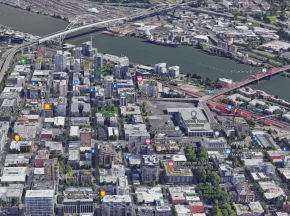
PBEM's Community Resilience Workbook is intended as the best and primary community curriculum resource. However, PBEM has not yet developed a curricula aimed at the particular needs of persons who reside in "vertical communities": apartment or condo buildings. The Vertical Communities E-Prep Packet is posted here to fill that demand.
Specifications
The packet pages can print on a regular home printer at 8 ½" x 11" sheets.
Appropriate Use
TBA
Facilitators can supplement the packet materials with information found at the NET Tumblr "Vertical" tag: https://portlandnet.tumblr.com/tagged/vertical.
Project history
In 2015, Pearl District NET Team Leader John Warner completed his first iteration of the packet, and it was published to the NET Tumblr in August 2016. The Pearl District Neighborhood Association successfully used this curriculum to organize no less than 35 buildings as of 2020, and other "vertical communities" have adopted and adapted it to their own use as well.
Retired Community Education Curricula
The following curricula is not published, distributed, or specifically recommended by PBEM and cannot be requested from PBEM. Information about these curricula are posted here in case reviewing them is useful to anyone organizing their communities, and readers can see how others have tried to solve organizing communities around preparedness.
The list below includes curricula PBEM at one time distributed. In order to preserve institutional memory, this article also explains why PBEM discontinued distributing each of the curricula.
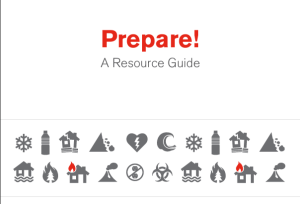
Red Cross Prepare! Resource Guide
| Red Cross produces this publication and PDFs are available in English, Spanish, Vietnamese, and Russian at: https://www.redcross.org/local/oregon/about-us/our-work/preparedness-resources.html . |
Before development of the Community Resilience Workbook, PBEM distributed the Red Cross Prepare! Guide as one of its primary informational resources. PBEM discontinued distributing it in favor of creating a publication that was less text heavy, narrowed down in scope, and Portland-specific. It runs about 29 pages (much of it in small font). The Guide's content, nonetheless, serves as an authoritative resource.
Map Your Neighborhood (MYN)
| The State of Washington produced MYN and their official page for it is at: https://mil.wa.gov/map-your-neighborhood. |
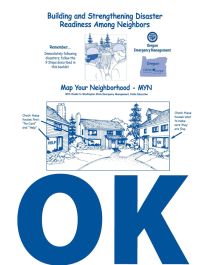
For Portland, the Community Resilience Workbook replaces MYN. PBEM ultimately discontinued MYN owing to poor design, copyright status, difficulty to print at home (the design included staggered saddle stitched pages...seriously?), lack of availability in multiple languages (though they did produce some Spanish materials), and outdated methodology. MYN produced different versions for rural communities and for vertical communities.
The State of Washington (which initially produced MYN) also posted a series of facilitator videos accessible HERE. However, Washington discontinued MYN in 2021, to be replaced by a Be 2 Weeks Ready program. MYN materials are available for download HERE.
Know Your Neighborhood (KYN)
| We don't have an electronic copy of the handout, but you can download a lot of information about the KYN project HERE. |
KYN was MYN, but redesigned and modified by Portland's Office of Neighborhood Involvement to include a section on crime prevention. KYN had many of the same issues as MYN and PBEM discontinued distribution. It's unclear when KYN was formulated, but PBEM was distributing it at least since 2008.
Other Community Resilience Curricula
The following curricula is not published, distributed, or specifically recommended by PBEM and cannot be requested from PBEM. Information about these curricula are posted here in case reviewing them is useful to anyone organizing their communities, and readers can see how others have tried to solve organizing communities around preparedness.
Obviously, this Wiki cannot make space for every piece of community education curricula ever designed. The curated list below includes curricula PBEM has considered adopting/adapting, or that Portlanders may hear about or come across at community events.
Be 2 Weeks Ready
https://www.oregon.gov/oem/hazardsprep/pages/2-weeks-ready.aspx
Disaster Preparedness Tokyo Manual ("Tokyo Bosai")
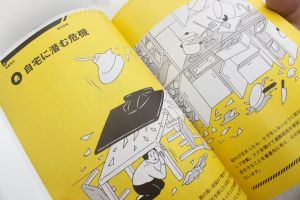
PDF available in English at: https://www.metro.tokyo.lg.jp/english/guide/bosai/index.html.[2]
Tokyo Bosai is a disaster preparedness manual (modeled after a manga) developed for Tokyo households by the Tokyo Metropolitan Government and available in English. Though the content is comprehensive and high quality, PBEM has declined to publish and distribute it. Printing costs for a manual of this size makes for a very low return on investment (particularly printing information that anyone can find online for free). Though the manual is popular in Japan, there is no credible data suggesting Portlanders consume disaster preparedness information the same way Tokyoites do.
From the website linked above:
The Tokyo Metropolitan Government has compiled a manual called “Disaster Preparedness Tokyo” (Tokyo Bousai) to help households get fully prepared for various potential disasters, including an earthquake directly hitting Tokyo. “Disaster Preparedness Tokyo” is tailored to the various local features of Tokyo, such as its urban structure and the lifestyles of its residents. It contains easy-to-understand information on how to prepare for and respond to a disaster. This information is useful both in the event of an emergency and to help you prepare proactively now.
A Portland-centered version, created by a local artist, is rumored to be published soon.
Connection is Protection
PDF available at: https://fairvieworegon.gov/431/Emergency-Preparedness
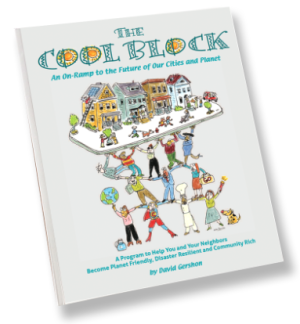
Cool Block
This curriculum, developed in California, came on radar from an online article. Cool Block takes an approach improving resilience around climate change and disaster. Their website teases some interesting approaches, but it does not appear that their workbook is available for purchase.[3] It's also a little suspicious because there's no shortage of vaunted fanfare about the program, but no published results or outcomes are available. You can find more information from the creator's white paper, and from the U.N.'s page about the program.
Multnomah County Earthquake Primers
Multnomah County has published their own earthquake prep material and their primer is available in eleven languages. Available at: https://www.multco.us/global/earthquake-primers-11-languages
PHLUSH Twin Bucket Pamphlet
PHLUSH is a national pioneering sanitation organization with roots in the Portland area. They produced emergency toilet information (click HERE) in 2013 that was replaced with the Emergency Toilet Guidebook. Notable for inclusion of tap-up sink building instructions.
Notes and References
- ↑ City staff can reference P&D orders #1250355 (06/14/23); #1223157 (03/10/20); #1222835 (03/31/20); #1220059 (12/04/19)
- ↑ See also: https://designmadeinjapan.com/magazine/graphic-design/tokyo-bosai-a-manual-for-disaster-preparedness/
- ↑ In fact, it's the only book specifically NOT for sale on the parent institute's website. How weird! https://empowermentinstitute.net/books/